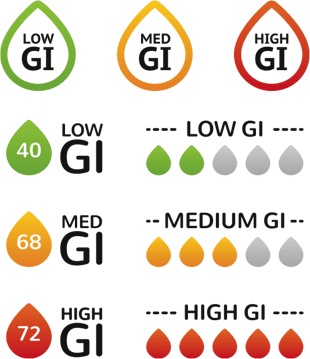The Low Glycemic Index Diet & Its Benefits for Older Adults
Ashley Graven, RD, LD, CPT | Feb 2, 2016
In today’s world, there are so many different nutrition focuses; it can be difficult to know what to believe or what to follow. It can be overwhelming to think of all of the different ways to eat and reasons to eat that specific way, as well as, figuring out what the true benefits are.
As we age, it is important to begin to look more closely at nutrition intake, what is being consumed on a daily basis, and what kind of fuel our body is getting to function optimally. You may have heard the phrase “glycemic index” before, and that is exactly what we are going to dive into in this blog – focusing on what glycemic index means, why it matters, and how to incorporate it into your lifestyle.
What Does “Low Glycemic” and “Glycemic Index” Mean?
 The term “low glycemic” refers to how a food that contains carbohydrate raises your blood glucose. Blood glucose is the same as blood sugar – the sugar in your blood stream. I’ll get into the benefits of regulating your blood sugar levels later, but for now, we are going to focus on what glycemic index is and its meaning.
The term “low glycemic” refers to how a food that contains carbohydrate raises your blood glucose. Blood glucose is the same as blood sugar – the sugar in your blood stream. I’ll get into the benefits of regulating your blood sugar levels later, but for now, we are going to focus on what glycemic index is and its meaning.
With your glycemic index, comes a scale or a ranking of carbohydrate containing foods. The scale takes a food and compares the glycemic load, or the ability to raise one’s blood sugar, to a piece of white bread or actual glucose itself. The glycemic index scale ranges from 0-100. The higher the blood sugar rises from that particular food, the higher the glycemic index ranking. As a rule of thumb:
- Low glycemic index: score of 55 and below
- Medium glycemic index: score of 56-69
- High glycemic index: score of 70 and above
There are different things that influence the glycemic index of a food, some examples are:
- Amount of fiber or fat within a product
- Ripeness or storage time
- Method of cooking
- Food processing or preparation methods
Foods with a lower glycemic index compared to white bread include, steel-cut oatmeal, sweet potatoes, non-starchy vegetables, and 100% whole wheat bread. Higher glycemic index foods are those like bagels, russet potato, pretzels, or instant oatmeal. Making slight changes in the types of food you are consuming can decrease the glycemic load of that food on the body and result in health benefits long-term.
What is the Low Glycemic Index Diet?
The low glycemic index diet has a specific focus on controlling blood sugar levels through lower glycemic food choices. This particular diet is typically associated with helping those who have been diagnosed with diabetes; however following this diet can help the overall health of anyone. The goal is to stabilize blood sugar levels within the body to optimize the body’s response to glucose, which in return will increase fat burning and help overall disease risk. The beauty of this “diet” is that when you take calorie counting out of the equation and focus on the quality of your foods and specifically the glycemic load, it is easier to follow and enjoy what you eat.
An important note: Just because a food has a low glycemic index, does not necessarily mean it is healthy. The glycemic index is only one component of what makes a food a healthier choice.
What are the Benefits of the Low Glycemic Index Diet? Why is it Important for Older Adults?
The major benefits of following a low glycemic index diet may be better blood sugar control, ability to manage diabetes, prevent the diagnosis of diabetes in the future, reduce heart disease risk, and some say it may help with weight loss. This is important for older adults because as we age our body depends on adequate fuel to function at our best. If we choose to focus on higher quality foods with higher fiber, this can be one easy step to a healthier you!

Ashley Graven, RD, LD, CPT
Life Time Fitness
Registered & Licensed Dietitian/Weight Loss Coach
Certified Personal Trainer
